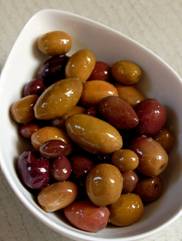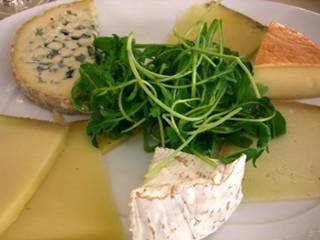Nibbles
Cocktail party fare should be light, but filling enough to stave off any evils of excessive alcohol consumption. By providing your guest with a balance of small snacks and a couple of appetizers, beverage/food equilibrium will be assured.
Light snacks
Olives:
Put a nice mixture in a decorative bowl or bowls depending on the scale of your party, along with an accompanying ramekin for the pits. Set out toothpicks in small shot glasses for neat picking.
Nuts:
Here are two simple recipes for cocktail nuts, a critical mainstay of cocktail accompaniment. These sweet or savory variations will please every palate. Depending on the size of your party, put these in a decorative bowl or bowls so they are easily accessed.
Cheese:
 Everyone loves a good cheeseboard, few things are easier to prepare. A nice selection of cheese interspersed with some fruit, crackers and other tidbits is a cornerstone of any cocktail party. Whether you choose to be a little more adventurous in your selection or stay strictly domestic, cheese is the consummate crowd pleaser.
Everyone loves a good cheeseboard, few things are easier to prepare. A nice selection of cheese interspersed with some fruit, crackers and other tidbits is a cornerstone of any cocktail party. Whether you choose to be a little more adventurous in your selection or stay strictly domestic, cheese is the consummate crowd pleaser.
A visit to any of the amazing local cheese shops or cheese counters at your favorite market will enable you to sample the cheese and they will also provide advice for your spread. I try to balance my selection with 2-3 cheeses of diverse but complimentary flavors. Varying the flavor intensity of your selection will satisfy a variety of palettes. Sample all cheese before purchasing. Avoid any cheese that asserts a pungent aroma, while many enjoy these strong cheeses they can dominate and become a turn-off for other guests. It is also important to consider the shape and color of the various cheeses, no matter how great the flavor a monochromatic selection of white cheese will not be as appetizing as a varied assortment.
Here are some of my favorites:
Mild:
Hudson Valley Camembert (NY)
Coach Farm Goat Cheese (NY)
Bocconcini (Italy)
Shelburne Farms Cheddar (VT)
Grafton Village Cheddar (VT)
Jasper Hill Farm Constant Bliss (VT)
Bucheron (France)
Cage Aged Gruyere (Switzerland) 1st place in 2008 World Cheese Championship
5 spoke Creamery, Tumbleweed (PA)
Aggressive Flavors:
Cabrales (Spanish Blue)
Pecorino (Italy)
Parmigiano-Reggiano (Italy)
Maytag Blue (IA)
Don Juan, Aged Manchego (Spain)
If you would rather stick with one cheese here are a few options:
~A wedge of Parmigiano-Reggiano or other hard Italian cheese and olives. Place the wedge of cheese on a cutting board. Use a cheese knife to crumble off about a third of the cheese. Put the olives in a bowl on the board with a shot glass of toothpicks. One of my favorite types of olives is the San Agostino which are available at Agata and Valentina on the Upper East Side as well as many other Italian markets. These bright green gems have a fruiter taste than more traditional brined olives and are a lovely counterpart to the saltiness of the cheese.
~A round of a soft cheese such as Brie or Camembert at room temperature. Slice a few wedges of the cheese to get the round started. Serve with sliced baguettes, slices of pear and a fruit paste such as fig or quince that can be found in market cheese sections. Spoon the paste directly on the cutting board or place in a small ramekin.
~Boconcinni (mini-mozzarella balls) in a large bowl placed on a platter with antipasto items. These balls are readily available at Italian markets or in olive bars at places like Whole Foods. Go crazy - serve with roasted red peppers, artichoke hearts, and sundried tomatoes in olive oil. If you want to add more sustenance throw on some slices of Sopresetta (Italian salami), or other sliced sausage and some sliced baguette. Include a couple of small forks or toothpick for spearing the antipasto and cheese.
Presentation
I have a great marble pastry board that is always on my counter. I think it gets more use as a cheese platter than for pie crust making. It is the ideal surface for presenting and cutting cheese. And I purchased it at Ikea. Cutting boards also make great platters and of course are perfect for cutting. Try to avoid plates or ceramic platters for cheese boards as they can be awkward for cutting as the cheese will slip. Invest in a few good cheese knives- these are usually sold in sets and offer a variety of shapes and blades. Do not confuse cheese knives with spreaders. Spreaders are flat knives that are used for spreading not cutting. Each cheese should be paired with a knife that works for the accompanying cheese.
Once you have selected the platter, place your cheese on the board, space out evenly then slice about a third of the cheese and arrange casually as if it has just fallen off the cheese wedge - no need for fancy fanning - this is equivalent to those cellophane-tipped toothpicks - don’t use those either. Once your cheese is casually cut, place the appropriate knife next to the cheese so your guest can continue cutting.
After the cheese is placed comes the best part - the cheese accoutrements! This is where your creativity comes in. Select varying flavors that will enhance and balance the cheese. Also, be inspired by what is fresh and in season at your local farmer’s market. I typically will slice up some green apples and pears and put them in a small bowl and squeeze them will a little lemon juice so they will not brown. Depending on the size of your platter you can keep these slices in a small bowl and place on the platter or spread the slices directly on the platter. Fresh raspberries and blackberries also add a nice touch of color and can be sprinkled across the platter. To balance the sweetness of the fruit, intersperse walnuts or other mild nuts on the platter. I spread the crackers for the cheese on the actual platter. Some prefer to put the crackers in a basket but I find that incorporating the crackers onto the actual board makes for a much more integrated presentation and saves table space. There are endless varieties of crackers of every shape and flavor available, however if you wish to add a fanciful touch here is a recipe for icebox crackers that is sure to be a crowd-pleaser.
